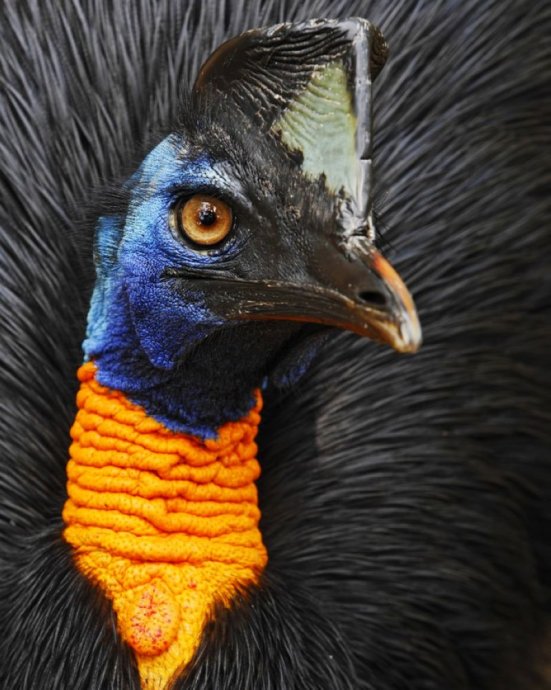Crane ostrich – the most dangerous bird
Keepers need to carry shields when approaching crane ostriches. Because of its six 12-centimeter-long claws that are as sharp as a dagger. And extremely good at kicking.
When it feels threatened, it will launch an attack, sharp claws combined with powerful legs, able to hook out the enemy's internal organs, and it can be fatal to dogs and horses with just one blow.
In 2007, it was listed by the Guinness Book of World Records as "the most dangerous bird in the world". The first recorded case of a crane ostrich death was on September 5, 1929.
Philip, a 16-year-old Australian boy at the time, encountered a crane ostrich on the edge of the forest, and a curious Philip hit it with a stick.
The invaded crane ostrich immediately launched a fierce counterattack. It kicked Philip down a few meters away. Then he rushed over and slashed Phillip's neck with his claws, causing the boy to die of excessive carotid artery blood loss.
Since then, every few years, there have been records of humans being killed by cranes and ostriches.
But such a fierce bird is a vegetarian animal, mainly to collect fallen berries for a living, adult male crane ostrich can reach 1.6 meters to 2 meters tall, weighing about 180 pounds.
The legs are extremely muscular, running speeds of up to 60 km / h, once humans are targeted by it, it is almost impossible to escape.
The ostrich is a close relative of the ostrich, but it is more grumpy than the ostrich, and due to insufficient fossil data, the specific evolution of the ostrich is still unknown.
But the shape of the crane ostrich is very close to that of the oviraptorosaurs 75 million years ago, especially the shape of the crown, which is almost exactly the same.
It is speculated that it is possible that the crane ostrich and the oviraptorosaur may have the same ancestor, just as the Tyrannosaurus rex and the chicken had the same ancestor.
Chickens belong to the "suborder Obitopod", which first appeared in the Cretaceous Period, if you go back, you will find that the ancestor of the "Suborder Iris" is a guy called "Virtual Bone Dragon", and this "Virtual Bone Dragon" is also the ancestor of Tyrannosaurus Rex.
So the crane ostrich and the oviraptorosaur, the chicken and the tyrannosaurus rex, they are very distant relatives, with a certain similarity, but there is no direct genetic evolutionary relationship.
Like the grumpy carnivorous dinosaurs, the vegetarian crane ostrich is very aggressive and has a strong sense of territory.
Its territory is usually 50 square kilometers, and as soon as an alien breaks into the territory, it will immediately attack. Even after the other party escapes from their territory, they will still chase and fight fiercely, and throw them out of the two miles.
And the female crane ostrich has a more grumpy temper.
According to observations, whenever the female crane ostrich and the male crane ostrich have finished mating, the male bird has to run quickly, leave the territory of the female crane ostrich, run a little slower, and the female bird will make a violent beating to the male bird.
Crane ostriches still practice polygamy, a female bird will mate with multiple male birds, after each mating, the hot female bird, after giving birth to eggs and growing away, even the eggs are green!
The task of hatching and taking care of the young birds is completely entrusted to the male crane ostrich, who travels the mountains and plays with the water by himself, and no longer pays attention to it, and a considerable part of the male crane ostrich becomes the receiver...
After the little crane ostrich broke out of its shell, the mother of the crane ostrich still did not care about anything, and left it all to the care of the crane ostrich father, which is completely opposite to the breeding method of most animals in nature.
By the time the little crane ostrich reaches 3 months, it is about the size of a rooster, and their ferocious nature begins to be revealed, and siblings continue to fight.
Once the fight exceeds the limit of the crane's father's patience, it will give all the little crane ostriches a violent beating, and when the little crane ostriches are 9 months old, they will begin to live independently.
Since the crane ostrich is very curious about the glowing things, when it sees the charcoal ashes abandoned by humans, it will go up and peck it. The local natives also called it "cassowarman"
The skin of its head is blue-purple, the flesh of its neck is bright red, and its feathers glow with dazzling sapphire luster.
This beautiful feather is deeply loved by European and American noblewomen, which has led to the large-scale hunting of crane ostriches, just to obtain its beautiful feathers.
For nearly 300 years, the underground trade in crane ostriches has existed, and by 2019, the number of crane ostriches has dropped by 95%;
In nature, there are only about 1,500 crane ostriches at risk of extinction, which is rarer than giant pandas.
According to incomplete statistics, in the 20th century alone, more than 110 species and subspecies of mammals were extinct by humans, and more than 140 species and subspecies of birds were extinct by humans.
These animals include:
dodo
Great petrel
Spotted donkey
moa
Cape Beast
Japanese wolf
Bali Tiger
Antarctic wolf
North American passenger pigeon
Newfoundland White Wolf
Slaren manatee
Calerona long-tailed parrot
Kenai Peninsula Wolf
Taiwan clouded leopard
Mauritian parrot
Emperor woodpecker
Caucasian bison
Atlas Brown Bear
…
The list is long...
#Science #Birds #Animals# #我要上微头条 #
